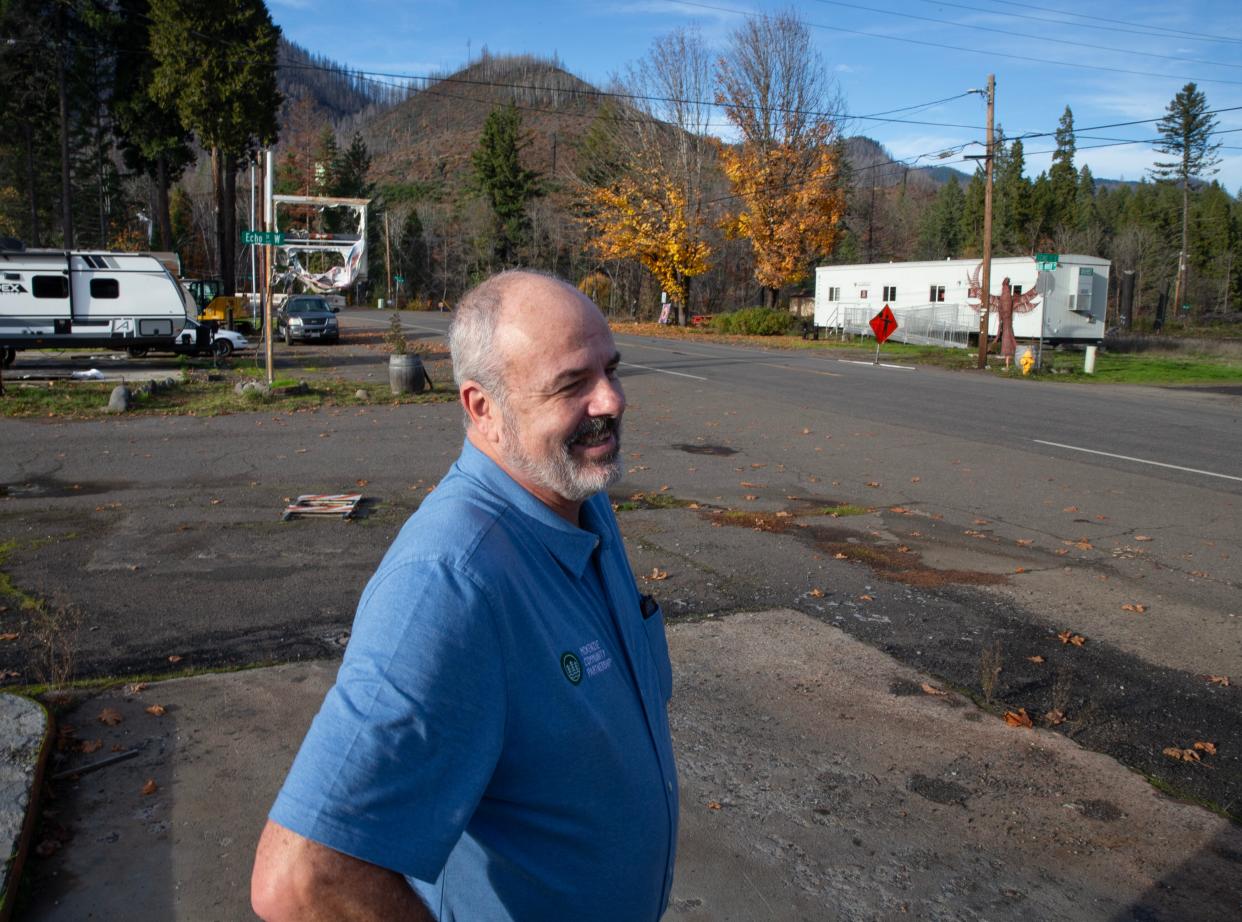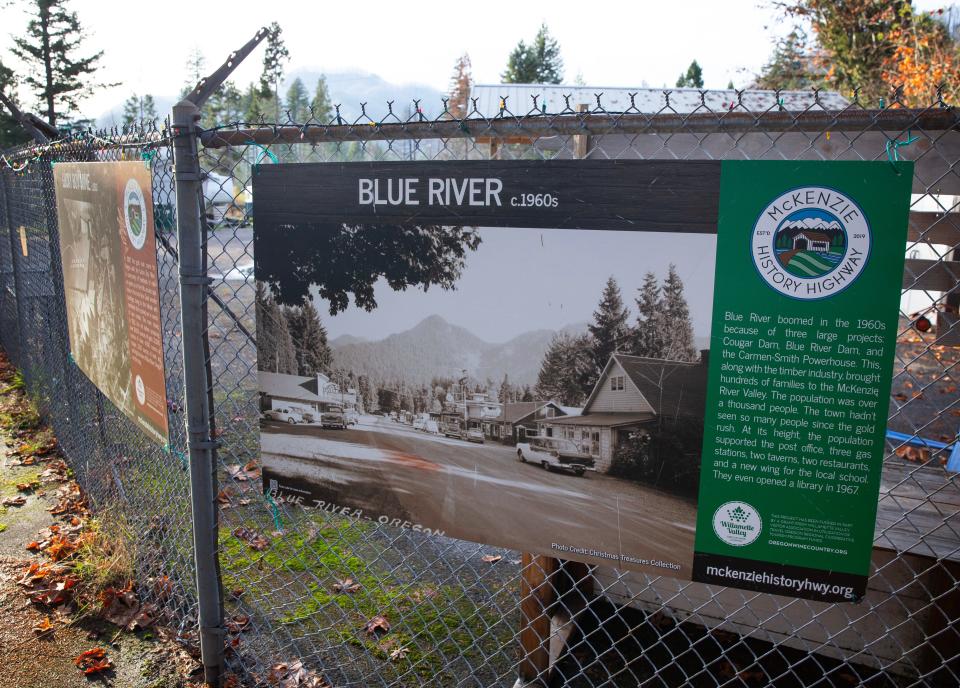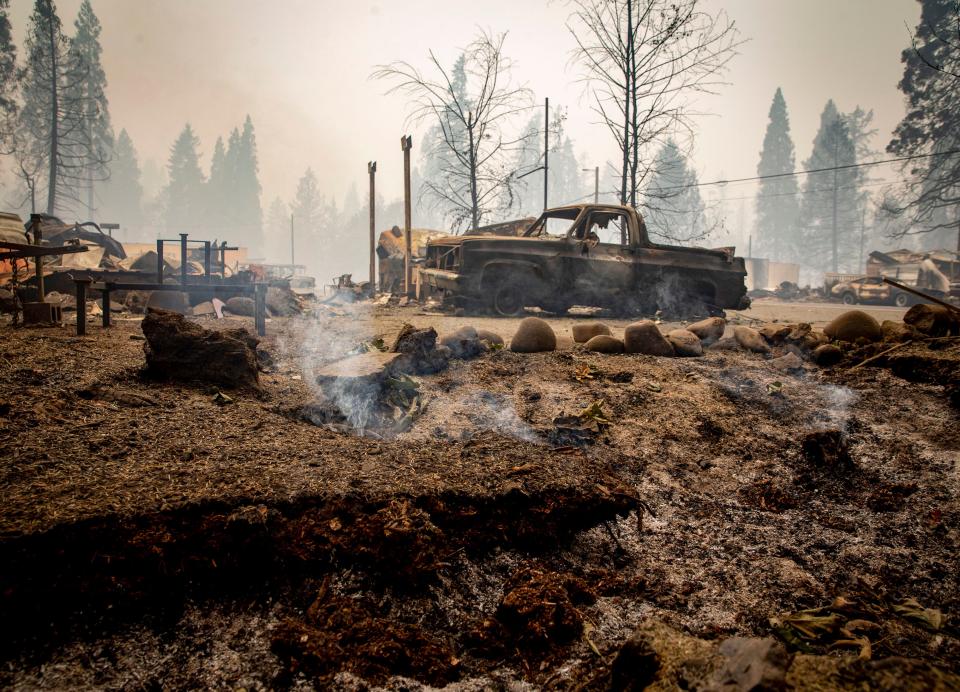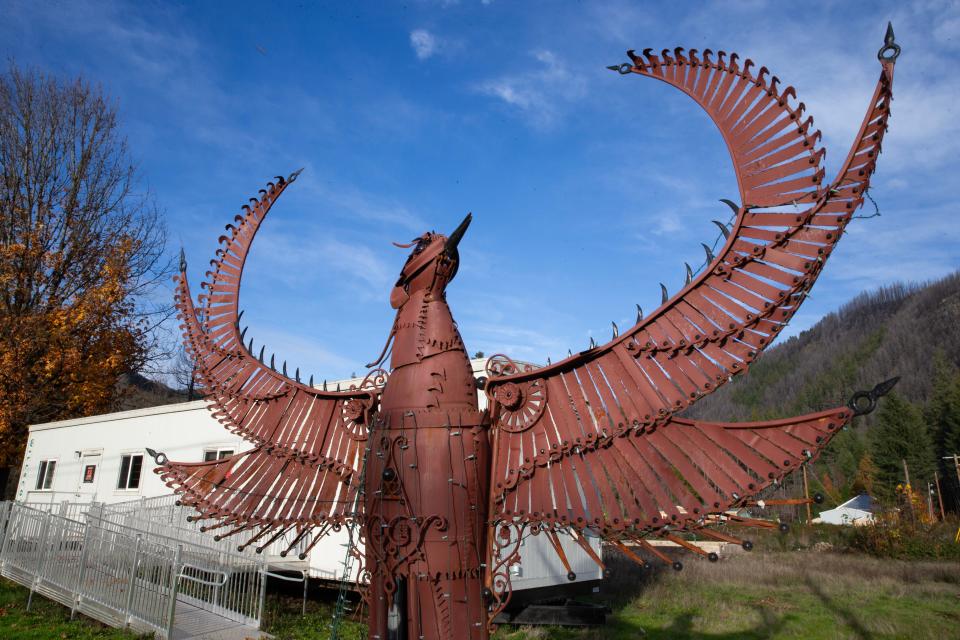Lane County, Blue River explore what it takes to make a small, rural community successful

About 30 community members spent a recent evening perusing tables laid out with maps in the McKenzie High School gym, asking questions about three zoning plans for the redevelopment of Blue River three years after the Holiday Farm Fire devastated communities along the McKenzie River Valley.
Lane County designated Blue River as a “rural community” in 1984. The changes being considered will encourage rebuilding and development in line with community needs to serve the town of about 820 residents.
The Blue River Complete Community Plan also would allow for accessible transit for walking, biking and busing, greater density and more flexibility as the town continues to rebuild.
Some residents at the meeting said they are hopeful to see implementation of mixed-use zoning to provide a spark to rejuvenate the town.
“The context behind this community plan and the fact that this was a community devastated by the Holiday Farm Fire weighs in on this project," said Taylor Carsley, senior planner for the county.
“That, of course, was a super emotional event that always factors into any kind of subsequent activity," Carsley said. "The county and the project management team as a whole are really sensitive to that fact and are really sensitive to the emotions behind what the community is trying to do.”
Blue River history
Gold was struck in 1863, bringing miners and their families. Blue River was founded in 1900. The year 1924 saw the closure of the Blue River Mining District as the logging and timber industry gained traction, shifting the local job market from mining jobs to timber. The convenience of the automobile also made Blue River a destination for recreation and tourism.
The town’s heyday occurred in the 1960s with workers needed to complete three dam projects — the Leaburg Dam, the Cougar Dam and the Carmen-Smith Dam.
Two Forest Service ranger stations served the area and the town bustled with activity. There were three restaurants, a hotel and saloon, two bars, a library, multiple gas stations and other amenities.

Life in Blue River shifted dramatically after the shuttering of one of the ranger stations, a new highway that bypassed the town's business district and a lack of local jobs and affordable housing.
After the devastating 2020 wildfires, the town has started rebuilding the library, a fire station and a medical center on Blue River Drive.
The Blue River Complete Community Plan
The Blue River Complete Community Plan project, funded in part by a grant from the state’s Transportation and Growth Management program, aims to amend the Lane Code and Rural Comprehensive Plan to allow rezoning congruent with the values of community members and their needs for development.
The county hopes the project can serve as a model for other unincorporated and rural communities.
The project involves collaboration between Lane County’s Planning Department, the Lane Council of Governments, the Oregon Department of Land Conservation and Development, Eugene-based design firm Urban Collaborative and residents, property owners and stakeholders of Blue River and the McKenzie River Valley.

The county planning department has been connecting with community members and multiple agencies supporting the project.
“The fact that it is an unincorporated community and a rural area outside of an Urban Growth Boundary is unique in that this is kind of the first time that the county is tackling this type of a project to develop a complete community plan for an unincorporated community,” Carsley said.
“It can be seen as maybe a little bit of a bridge in a way between an urbanized area and a rural area,” Carsley said.
A historic reassessment
Carsley said the project will benefit residents of unincorporated communities by studying a specific area and crafting land use amendments that allow for density to increase, improved flexibility in land use and by tailoring regulations to ensure Blue River is not disadvantaged by the changes.
Assistant Planning Director Lindsey Eichner said the project is historic because once communities are designated as unincorporated or rural, they are typically not revisited for rezoning or amendments to land use.
“So this is our first time that we are doing a look back and determining ‘Are the zones appropriate for the existing uses? What does the community want for future uses?’” Eichner said. “So really this is brand new for us. We don’t have anything to reference back to locally.”

As the county and its partners pave paths for rezoning, challenges like necessary changes to septic systems and community water systems are at the forefront of the project.
“One of the other major issues of the rebuilding is septic systems. The lots are so small,” Eichner said. “Luckily they will have a very good community water system once all the upgrades are made, which is amazing because if they had to have a well and a septic system, that would kill downtown."
“It would be impossible otherwise,” Carsley said of the need to readdress zoning in Blue River to account for smaller lot sizes.
While this is a unique project for Lane County, the need to address concerns related to rebuilding fire-affected communities is not. Going forward, other towns may look to the revitalization and redevelopment of Blue River as an example of what to do to best listen to and support survivors in similar communities.
Community Feedback
Oregon’s land-use planning goals adopted in 1974 made it so that “every inch of Oregon is planned and zoned” except for federal and tribal lands. This goal, largely enacted to limit urban sprawl and support comprehensive, fact-based land-use planning, also limits the kinds of developments available to communities statewide, particularly rural ones.
One of the folks working to push the needle and provide the county and its partners with feedback and input is Chris LaVoie, executive director of the McKenzie Community Partnership and owner of the former McKenzie River Mountain Resort, one of the businesses lost in the wildfires.
LaVoie has been accumulating public feedback and attempting to assist Blue River in a transition to a more European-style, walkable town since 2007, when plans to rezone Blue River fell flat in the midst of the 2008 recession.
He considers himself a “delusional optimist” and is happy seeing notable discussions and plans for Blue River.
Oregon's strict zoning, with a goal to stop urban sprawl, LaVoie said, is unintentionally limiting what unincorporated communities can do in terms of development.
“We want to protect the rural areas and stop that (urban sprawl) and I’m totally behind that,” LaVoie said. “What they did inadvertently, though, was just sign the death warrant for all rural communities and unincorporated communities.”
He said the project outreach he has seen and participated in so far has been indicative of how historic of a plan this is for the county and Blue River’s residents.
“I’ll never see it again in my lifetime. They just don’t do this,” LaVoie said. “I don’t even know if another county has done this in the state in our lifetimes, either. This is just that rare.”
While LaVoie continues to provide education and support to McKenzie River Valley communities through the nonprofit McKenzie Community Partnership, he acknowledges the timeframe for a project like this means it will be years before any progress is seen.
“The things we’re doing right now, it’s going to be five or 10 years before we really see a lot of these things come in place with any big, noticeable change and since we’re not going to get another chance in my life, let’s do it right,” LaVoie said. “What does it take to make a small, rural community be successful? Let’s put those elements in play so we can attract people to put good stuff in and be sustainable with it.”
For him, sustainable and thoughtful investments and developments are key components to see mixed-use zoning come into play positively in the unincorporated community.
“We’re forward thinking,” LaVoie said. “It’s about the people to come, not the people who are here.”
What’s next for Blue River?
Lane County and its project partners are assessing feedback and will present three alternatives to the planning commission at a Dec. 5 meeting. From there, the commission will issue recommendations and the county will assist in the creation of a drafted plan.
An additional community meeting will be hosted in late winter or early spring to present the drafted plan before it will be sent back to the planning commission for formal processing. Eventually, the plan will be sent to the Lane County Board of Commissioners for approval.
Eichner said a major priority throughout this process continues to be community feedback from residents of the McKenzie River Valley and Blue River.
“We’re really hoping to get it right and get community buy-in. And hopefully they feel heard. … We really want them to feel heard,” Eichner said. “It’s not our community, it’s their community so we want to make sure that they feel heard and are happy with the outcome.”
Hannarose McGuinness is The Register-Guard’s growth and development reporter. Contact her at 541-844-9859 or hmcguinness@registerguard.com
This article originally appeared on Register-Guard: Oregon community weighs zoning changes amid wildfire rebuild

